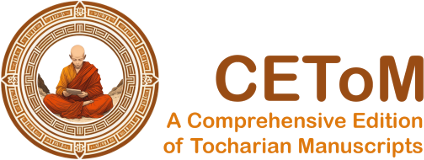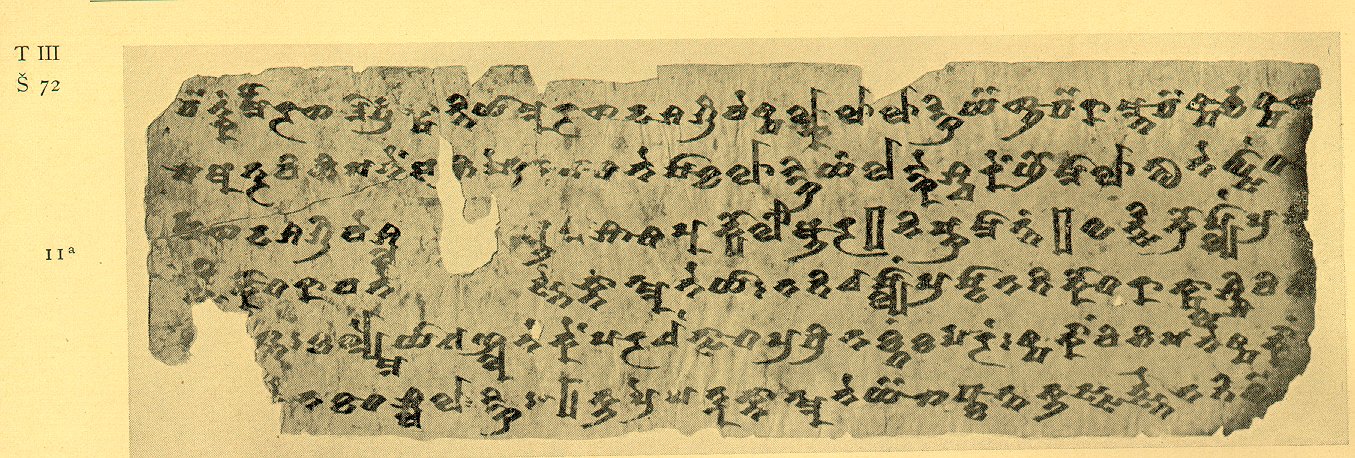A 11
| Known as: | A 11; THT 644 |
|---|---|
| Cite this page as: | Gerd Carling; Adrian Musitz (translation commentary). "A 11". In A Comprehensive Edition of Tocharian Manuscripts (CEToM). Created and maintained by Melanie Malzahn, Martin Braun, Hannes A. Fellner, and Bernhard Koller. https://cetom.univie.ac.at/?m-a11 (accessed 01 Jul. 2025). |
Edition | |
| Editor: | Gerd Carling; Adrian Musitz (translation commentary) |
Provenience | |
| Main find spot: | Shorchuk |
| Specific find spot: | Stadthöhle |
| Expedition code: | T III Š 72.11 |
| Collection: | Berlin Turfan Collection |
Language and Script | |
| Language: | TA |
| Script: | classical |
Text contents | |
| Title of the work: | Puṇyavantajātaka |
| Passage: | k |
| Text genre: | Literary |
| Text subgenre: | Jātaka/Avadāna |
| Verse/Prose: | prose; verse |
| Meter: | 665 (4x) |
Object | |
| Manuscript: | A 1-54 |
| Preceding fragment: | A 10 |
| Following fragment: | A 12 |
| Material: | ink on paper |
| Form: | Poṭhī |
| Number of lines: | 6 |
Images
Images from titus.fkidg1.uni-frankfurt.de by courtesy of the Thesaurus Indogermanischer Text- und Sprachmaterialien (TITUS).
Transliteration
(continues from A 10)
| a1 | ¯cä tkaṃ rmo ra¯ ¯s̝ mā cri kṣā nti yā mu ra¯ ¯s̝ da śa gri ve spa lkā lā lā ṅkri yä s̝la¯ ¯cä rā mna¯ ¯cä spa¯ ¯rk tma¯ ¯s̝ – |
|---|---|
| a2 | ¯m a tra vi bhi ṣa neṃ a bhi ṣe kyā ma¯ ¯s ne ṣā¯ ¯k lā ṅkri yaṃ la ṅke śva reṃ ño mā lā ntu ne wsāṃ ta¯ ¯m – |
| a3 | rma¯ ¯s̝ da śa gri ve śla ā mā śā¯ ¯s pu kyo lo ā¯ ¯r || ni ṣkra mā ntaṃ || wa rtsi kro plyāṃ pra ṣṭā – |
| a4 | rtsi ko¯ ¯t rā va ne sne knā nmu ne yā : na ti e ṣlyāṃ pra ṣṭā na ti ko¯ ¯t rā kṣtsā śśi vi bhi – |
| a5 | n[eṃ] – ¯s̝t : ka lyme yā e ñlu ne keṃ pa¯ ¯r eṃ tsā¯ ¯t pra cri na ktaṃ ka rpa raṃ : spa rkāṃ vi bhi ṣa ne spa rkāṃ [k]· |
| a6 | – – [n]e na ka¯ ¯t śla lā ṅkri : 1 || ku pre pa tnu knā nmu ne yä¯ ¯s̝ pka¯ ¯nt ku ssa tsne na ti wä – – |
| lf | 70 5 |
| b1 | – – n· na¯ ¯s̝ pu kta¯ ¯m ā lā su ne kka¯ ¯ts || a mo ktse pe nu knā nmu ne yä¯ ¯s̝ wä rce tswā tsu – – |
| b2 | [a] – [¯k] ṣu rma ṣi¯ ¯k sne pra¯ ¯s̝t śo lnä kse¯ ¯ñcä maṃ tne ā lyä kyāṃ pra ṣtaṃ śtwa¯ ¯r a mo ktse ā la kaṃ caṃ – |
| b3 | ya¯ ¯cä ytsi ka rya tsu ma¯ ¯s̝ ce¯ ¯m tmaṃ ṣñi ṣñi a mo kaṃ twā śśi o pa śśu ne kā swo ne pā [k]ra |
| b4 | śi ypa māṃ sa stra ṅka¯ ¯s̝ ñi a mo kyo ta s̝cä mplu ne ku pre ne wa lu ntā¯ ¯p ṣñi ā yä ntu – |
| b5 | ¯nt pka¯ ¯nt pe nu kā klo ñcä ska lpā mā¯ ¯r ce sa mnä¯ ¯s̝ wnā ka śa¯ ¯l tswā sa¯ ¯m || wä ttra ṅka¯ ¯s̝ na ṣnu ce – |
| b6 | ¯k ā yä ntu pukā¯ ¯k pu skā syo ka śa¯ ¯l ma lka ma¯ ¯m || tri ttra ṅka¯ ¯s̝ na ṣnu ce sma¯ ¯k ā yä ntu śwā¯ ¯l |
(continues on A 12)
Transcription
(continues from A 10)
| lf | 70-5 |
| 1a | wartsi kroplyāṃ praṣṭā ; (wa)a4rtsi kot rāvane ; sne knānmuneyā : |
|---|---|
| 1b | nati eṣlyāṃ praṣṭā ; nati kot rākṣtsāśśi ; vibhi(ṣa)a5neṃ – ṣt : |
| 1c | kälymeyā eñlune ; keṃpar eṃtsāt pracri ; nakt-äṃ kär-paräṃ : |
| 1d | spärkā-ṃ vibhiṣane ; spärkā-ṃ k· a6 – – ne ; nakät śla lāṅk ri: 1 ॥ |
(continues on A 12)
Translation
(continues from A 10)
| a1 | inclining ([his] hea)d he effected his mother’s pardon, and before the eyes of Daśagrīva he went from the town of Laṅkā and vanished towards Rāma. |
|---|---|
| a1+ | Thereupon the hero Rāma anointed Vibhīṣaṇa as king |
| a2 | and already gave him the kingship in the town of Laṅkā under the title of Laṅkeśvara [“lord of Laṅkā”]. |
| a2+ | Because of this Daśagrīva with his ministers was all finished. |
| a3 | || In the N.-tune:|| |
| a3+ | At the time that company had to be gathered Rāvaṇa split the company out of ignorance. |
| a4 | t the time that power had to be given,, he split the power of the Rākṣasas |
| a4+ | A and struck Vibhīṣana. |
| a5 | The proper advice from his brother he misinterpreted and the (good) dignity was lost for him. Vibhīṣana vanished from him |
| a5+ | and so vanished his rule, |
| a6 | and he perished with the town Laṅkā. |
| a6+ | Or if (they are) without knowledge, what is power, strength [and] energy, that is all inertia. |
| b1+ | Skilful ones, too, for lack of wisdom, lose their life just because of their skill, at the wrong time. |
| b2+ | Just like that at another occasion four craftsmen intended to go to some other country. There, when they manifested the skilfulness and merit of their respective skills, one [of them] says: |
| b4 | Through my art this is my ability: |
| b4+ | If I find the bones of a deceased, even [if] they have fallen apart, I will put them together again. |
| b5 | The second says: |
| b5+ | But I will join the bones completely with the sinews. |
| b6 | The third says: But the bones with flesh, |
(continues on A 12)
Other
| a5 | Die richtige Anweisung seines Bruders nahm er [scil. Rāvaṇa] falsch auf. (Schmidt 1974: 396-7) |
|---|---|
| b4+ | If I find the bones of a deceased, even [if] they have fallen apart, I will put them together again. (Peyrot 2013b: 247) |
| b4+ | Wenn ich von einem Gestorbenen seine Knochen, auch [wenn sie] auseinandergefallen [sind], finde, werde ich sie wieder zusammensetzen. (Schmidt 1974: 196) |
| b5+ | But I will join the bones completely with the sinews. (Peyrot 2013b: 247) |
| b5+ | Der Zweite sagt: "Ich aber werde euch eben die Knochen sämtlich mit Sehnen zusammenfügen." (Schmidt 1974: 227-8) |
| b6+ | But I will restore the bones with flesh, blood, skin, outer skin, and hair, exactly like before. (Peyrot 2013b: 248) |
| b6+ | Der dritte sagt: "Ich aber werde ihm eben die Knochen mit Fleisch, Blut, Haut, Fell(?) [und] Haar genauso wie zuvor völlig [wieder]herstellen." (Schmidt 1974: 495) |
Commentary
Remarks
| Transcription and references have been transferred from the "Text and Reference Database of the Tocharian A Language" (Gerd Carling Lund University) (funded by the Bank of Sweden Tercentenary Foundation and SCAS). | |
| Transcription and translation are based on Carling et al. 2009. |
Philological commentary
| The translation is largely based on Sieg 1944: 14-15, and Carling et al. 2009. | |
| n1 | The tune has 4x17 syllables, rhythm 6/6/5. |
| n2 | ālāsunekkdirectly picks up something said previously: A 2 a6 cami ālāsuneyis nu tsraṣṣune pratipakṣ nāṃtsu. Here it is argued: No, power without knowledge is inertia. This interpretation fits well with what came before (Ravana was strong but stupid). |
References
Online access
Edition
Sieg and Siegling 1921: 9-10; Sieg and Siegling 1921 p. 9, p. 10
Translations
Carling 2000: a3 a4 (285), b2 b3 (102, 288); Hackstein 1995: a1 (71), a5 (86), a6 (86, 163); Meunier 2013: a1 (152); Peyrot 2013b: b4 b5 (247), b4 b5 b6 (247), b5 b6 (247), b6 A 12 a1 (248); Schmidt 1974: a5 (396f), a5 (396-7), b4 b5 (196), b5 b6 (227f), b5 b6 (227-8), b6 A 12 a1 (495); Sieg 1944: a1 a2 a3 a4 a5 a6 b1 b2 b3 b4 b5 b6 (14); Thomas 1952: a1 (57), a3 a4 (27), b6 (62); Thomas 1954: b2 b3 (738); Thomas 1957: a1 a2 a3 (159), a3 a4 a5 a6 (160); Thomas 1968: b6 A 12 a1 (228); Thomas 1972: b6 A 12 a1 (469); Thomas 1976: a5 a6 (228); Thomas 1979a: b6 A 12 a1 (244); Thomas 1979d: a2 a3 (150), a6 (150); Thomas 1983: b2 b3 (26); Thomas 1997: a6 b1 (105), a6 b1 (71), b5 b6 (95)
Bibliography
Carling, Gerd. 2000. Die Funktion der lokalen Kasus im Tocharischen. Berlin/New York: de Gruyter.
Carling, Gerd, Georges-Jean Pinault, and Werner Winter. 2009. A dictionary and thesaurus of Tocharian A. Volume 1: Letters a-j. Wiesbaden: Harrassowitz.
Hackstein, Olav. 1995. Untersuchungen zu den sigmatischen Präsensstammbildungen des Tocharischen. HS Erg.-Heft 38. Göttingen: Vandenhoeck & Ruprecht.
“The International Dunhuang Project: The Silk Road Online.” n.d. http://idp.bl.uk.
Meunier, Fanny. 2013. “Typologie des locutions en yām- du tokharien.” Tocharian and Indo-European Studies 14: 123–85.
Peyrot, Michaël. 2013b. The Tocharian subjunctive. A study in syntax and verbal stem formation. Vol. 8. Brill’s Studies in Indo-European Languages & Linguistics. Leiden/Boston: Brill.
Schmidt, Klaus T. 1974. “Die Gebrauchsweisen des Mediums im Tocharischen.” PhD, Universität Göttingen.
Sieg, Emil. 1944. Übersetzungen aus dem Tocharischen I. Abhandl. d. Preußischen Akad. d. Wissenschaften, Jg. 1943, Phil.-Hist. Kl. 16. Berlin: Akad. d. Wissenschaften.
Sieg, Emil, and Wilhelm Siegling. 1921. Tocharische Sprachreste, I. Band. Die Texte. A. Transcription. Berlin/Leipzig: de Gruyter.
Sieg, Emil, and Wilhelm Siegling. 1921. Tocharische Sprachreste, I. Band. Die Texte. A. Transcription. Personal annotated copy of Wilhelm Siegling. Scanned by Douglas Q. Adams with the technical assistance of Michael Tarabulski and Kevin Dobbins. Berlin/Leipzig: de Gruyter.
Thomas, Werner. 1952. Die tocharischen Verbaladjektive auf -l. Deutsche Akad. der Wissenschaften zu Berlin, Institut für Orientforschung 9. Berlin: Akademie-Verlag.
Thomas, Werner. 1954. “Die Infinitive im Tocharischen.” In Asiatica. Festschrift Friedrich Weller. Zum 65. Geburtstag, gewidmet von seinen Freunden, Kollegen und Schülern, edited by Johannes Schubert and Ulrich Schneider, 701–64. Leipzig: Harrassowitz.
Thomas, Werner. 1957. Der Gebrauch der Vergangenheitstempora im Tocharischen. Wiesbaden: Harrassowitz.
Thomas, Werner. 1968. “Zur Verwendung von toch. A oki/B ramt und A mäṃtne/B mäkte in Vergleichen.” Orbis 17: 198–231.
Thomas, Werner. 1972. “Zweigliedrige Wortverbindungen im Tocharischen.” Orbis 21: 429–70.
Thomas, Werner. 1976. “Zur tocharischen Entsprechung von skt. tāyin.” Zeitschrift für Vergleichende Sprachforschung 89: 221–30.
Thomas, Werner. 1979a. “Ein neues tocharisches Prātimokṣa-Fragment der Bibliothèque Nationale.” Zeitschrift für Vergleichende Sprachforschung 92: 235–68.
Thomas, Werner. 1979d. “Zur Verwendung von A śla, B śale, śle im Tocharischen.” Zeitschrift für Vergleichende Sprachforschung 93: 150–73.
Thomas, Werner. 1983. Der tocharische Obliquus im Sinne eines Akkusativs der Richtung. Abhandlungen d. Geistes- und Sozialwissenschaftlichen Klasse 6. Mainz: Verlag d. Akad. d. Wissenschaften und d. Literatur.
Thomas, Werner. 1997. Interpretationsprobleme im Tocharischen. Unflektiertes A puk, B po “ganz, all, jeder”. Vol. 3. SbWGF, XXXV. Stuttgart: Steiner.
Gippert, Jost, Katharina Kupfer, Christiane Schaefer, and Tatsushi Tamai. n.d. “Thesaurus Indogermanischer Text- und Sprachmaterialien (TITUS): Tocharian Manuscripts from the Berlin Turfan Collection.” http://titus.fkidg1.uni-frankfurt.de/texte/tocharic/thtframe.htm.




